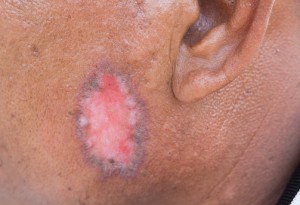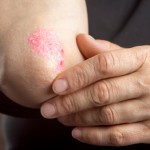Psoriasis vs. ringworm, differences in symptoms, causes, and treatments
 Psoriasis is commonly confused with other skin conditions, especially ringworm, so looking at Psoriasis vs. Ringworm symptoms and causes can help people zero in on proper treatment.
Psoriasis is commonly confused with other skin conditions, especially ringworm, so looking at Psoriasis vs. Ringworm symptoms and causes can help people zero in on proper treatment.
There are several types of skin conditions and different causes for them. To gain relief, of course, you need a proper diagnosis and treatment. Oftentimes, the skin condition psoriasis is confused with the skin problem called ringworm. There is a distinct difference between ringworm and psoriasis.
Psoriasis is a chronic skin condition. It is caused by the quick growth of skin cells and inflammation. Under normal conditions, skin cells grow, live, die, and fall off on a regular basis. When someone has psoriasis, skin cells grow rapidly and don’t fall off. As a result, the cells build up on the surface of the skin, and you end up with thick, scaly patches. The patches can be on your knees, elbows, lower back, or even your scalp.
Now let’s look at ringworm vs. psoriasis. With ringworm, you get a temporary red rash that forms a circle. Medical research tells us that it is caused by a fungal infection. Despite its name, ringworm is not caused by worms. The rash can spread if your skin makes contact with the skin of an infected human or animal.
Psoriasis vs. ringworm: U.S. prevalence and occurrence
Approximately two percent of Americans experience psoriasis, which can begin at any age. For the most part, it tends to happen first somewhere between the age of 20 and 30, and second onset is usually at 50 to 60 years old. Currently, about 7.5 million people in the United States have some form of psoriasis. Some of them experience joint inflammation, which leads to a diagnosis of psoriatic arthritis. Close to 90 percent of people with psoriasis get what is referred to as “plaque psoriasis”. These are patches of raised, reddish skin covered with silvery-while scales. There are other forms, including a type of psoriasis that can be found under the fingernails.
When we look at psoriasis vs. ringworm, the triggers are distinct. For example, with psoriasis, it is believed that genetic influences, environmental factors, or certain medications could cause the skin condition. Also, if a person has experienced psoriasis, emotional stress has been known to lead to flare-ups. With ringworm, though, living in an increasingly urbanized settlements, using community showers, being in close contact through sports, as well as wearing footwear that does not breathe can all contribute to the skin condition. Research shows that there are a large number of ringworm cases among marathon runners, miners, and soldiers. Also, outbreaks tend to occur in schools and institutional settings. Basically, ringworm is an infection caused by fungi that live in soil. Humans and animals can get ringworm after direct contact with this soil. Ringworm tends to be more common among children since they share a lot.
Ringworm vs. psoriasis: Comparison chart
Let’s take a closer look at ringworm vs. psoriasis. We have already established that in psoriasis the rash appear as dry, thick patches with silvery-white scales, and that the ringworm looks like dry, red circular patches.
Here are some other comparisons between the two skin conditions:
Ringworm Psoriasis Appearance Patches two inches in diameterPatches occur in singles or clusters Patches vary in size
Patches can join together Location Appears usually on moist areas, such as armpits, feet, and groin Appears most often on elbows, hands, feet, knees, and lower back Timeframe Appears 10-14 days after exposure to infection Chronic skin disease Contagiousness Highly contagious Not contagious
Psoriasis and ringworm: Difference in signs and symptoms
 Psoriasis and ringworm difference, in terms of signs and symptoms, starts with the formation of the patches themselves. In the case of psoriasis, you develop red patches and then silvery scales start to appear over the red patches of skin. With ringworm, you have a red patch and possibly a scaly border around the edge of that patch. Below you will see what else you might experience with psoriasis vs. ringworm.
Psoriasis and ringworm difference, in terms of signs and symptoms, starts with the formation of the patches themselves. In the case of psoriasis, you develop red patches and then silvery scales start to appear over the red patches of skin. With ringworm, you have a red patch and possibly a scaly border around the edge of that patch. Below you will see what else you might experience with psoriasis vs. ringworm.
Psoriasis signs and symptoms:
- Dry, cracked skin that could bleed
- Soreness on spots
- Burning or itching sensation
- Thick, ridged, or pitted fingernails
- Clusters of patches that cover a large area
Ringworm signs and symptoms:
- Red patches that may or may not itch
- A circle with red bumps or scales or a clear center
- Red circles that overlap
- Red patches with uneven or irregular borders
- Cracked skin
- Hair loss
- Thick or yellowish-brown finger nail
- Pain under fingernail
- Boils on scalp
Difference between ringworm and psoriasis causes
Since ringworm comes from the spores of soil, it can spread easily. To avoid spreading the infection, people who already have ringworm should not share personal items, such as combs, towels, and clothing. It is important to keep in mind that people can also get ringworm from pets, including cats and dogs. A common way of children getting ringworm is from petting animals at the zoo or an exhibit. To avoid ringworm, children should make sure they wash their hands thoroughly when leaving an animal exhibit. Since ringworm can live on damp surfaces such as locker room floors and public showers, it is a good idea to not walk around barefoot in such places.
When it comes to psoriasis, the exact cause is unknown, but we do know that it tends to run in families and seems to be related to the functioning of our immune system. Sometimes, psoriasis can be triggered by a skin injury, including a cut or surgery. We also know that emotional stress, infections such as strep throat, and certain medications such as beta-blockers can trigger this skin condition.
Comparing psoriasis and ringworm: Risk factors and complications
The reality is, anyone can get psoriasis, but certain factors can increase your risk of getting this skin disease. As mentioned above, family history is a potential risk factor. Also, viral or bacterial infections can increase the chance of getting psoriasis. People with HIV, for example, are more likely to develop this skin condition than people who have a healthy immune system. Children who tend to get strep throat a lot could also be at increased risk of getting psoriasis. While we can’t say for certain why, research shows that excess weight is a risk factor. It seems that psoriasis likes to develop in skin creases and folds. Studies have also indicated that smoking increases the risk as well as severity of psoriasis.
If you have psoriasis, you should be aware that there could be complications associated with it. We have already mentioned psoriatic arthritis, which can cause joint damage and pain, but psoriasis can also lead to eye disorders. There is also evidence that people with psoriasis have a greater chance of getting type 2 diabetes. High blood pressure, Parkinson’s, and kidney disease have also found in those who suffer from psoriasis.
While ringworm is common, people who have weak immune systems have difficulty fighting it off. For example, if someone has HIV or has recently been through chemotherapy treatment, infections are more likely to spread.
Children often contract ringworm around public pools. In recent years, water shoes, traditionally worn at the beach to protect feet from being cut on shells or stones, have become popular at community pools as a way to shield people from infections like ringworm. Since children are at greater risk due to sharing space and objects, regular hand-washing and use of hand sanitizer is encouraged at childcare centers, schools, and community gathering places. Ringworm can spread from one area of the body to another, especially through scratching. It can be further complicated if the skin breaks, because it can then lead to other bacterial infections, which could require antibiotics. When it comes to scalp ringworm, one possible complication is permanent scarring and bald patches.
Differentiating psoriasis and ringworm: Diagnosis and treatment
A physical exam and medical history will help a doctor determine whether or not you have psoriasis. An examination of your skin, scalp, and nails can tell a lot. In some cases, a doctor will take a skin biopsy to help determine the exact type of psoriasis.
While there is no cure for psoriasis, treatments can lessen the severity of the symptoms and reduce the number of outbreaks a person experiences. The treatment really depends on how bad a person’s skin condition is. A doctor might suggest topical ointments, oral medications, injected medications, or perhaps, light therapy. Light therapy can slow down or even stop the growth of skin cells in the affected area.
Ringworm can be diagnosed by looking at the skin and reviewing symptoms with the patient. Sometimes, small skin scrapings are examined under a microscope or are sent to a lab for fungal culture.
Treatment for ringworm can include ointment or cream, or antifungal medications. With treatment, many cases of ringworm clear up in two to four weeks.
Both psoriasis and ringworm can be uncomfortable and unsightly. While ringworm clears up with treatment relatively quickly, psoriasis can be more stubborn. Plus, psoriasis is chronic, meaning, you have it for life. The best you can hope for is finding a way to keep it under control – learn to manage the triggers in order to minimize the flare-ups.
One big difference between ringworm and psoriasis is that psoriasis can impact the quality of a person’s life. It can lead to depression and low self-esteem, as well as social isolation. Proper diagnosis and treatment are vital, so people can get the skin condition under control and avoid the negative emotional pitfalls.
-
Shape Up 4Alternative Weight Loss Solutions
I am embarrassed to admit how many different commercial weight loss pr
-
Weight Loss Plans - Easy Weight Loss Exercises
Different kinds of weight loss methods are available today and new one
-
7 weight loss myths disproved!
You dont have to give up your favourite foods to lose weight, says fi
-
Begin With The Mind And The Body Will Follow
It is commonplace knowledge in the weight loss industry that just goin
-
Boost Your Metabolism: 3 Quick and Easy Ways to Rev Your Body’s Fat Burning Machine
You have probably heard that, to lose weight, you need to boost you
-
How to Lose Your Body Fat Safely and Naturally
Losing fat can be a very difficult task,
- DON'T MISS
- What Is A Breakthrough With Food and Weight Anyway?
- Weekend Weight Loss – Fitness Tips and Tricks To Stay on Track
- Consistency - The Secret to Vibrant Health
- Introducing Fruit, vegetables and All-natural Food items for Safe Weight Reduction
- Comparing Nutritional Values of Edible Seeds
- Effective Weight Loss For Todays Busy Lifestyle
- Simple Tricks To Make Yourself Eat Less
- Five Habits That Can Contribute To Being Overweight
- Lose Fat With This Information
- Shed Fat Completely With Hardly Any Misery Or Food Cravings




